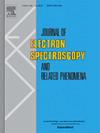Attosecond dynamics of electron scattering by an absorbing layer
IF 1.5
4区 物理与天体物理
Q2 SPECTROSCOPY
Journal of Electron Spectroscopy and Related Phenomena
Pub Date : 2025-03-10
DOI:10.1016/j.elspec.2025.147535
引用次数: 0
Abstract
Attosecond dynamics of electron reflection from a thin film is studied based on a one-dimensional jellium model. Following the Eisenbud–Wigner–Smith concept, the reflection time delay is calculated as the energy derivative of the phase of the complex reflection amplitude . For a purely elastic scattering by a jellium slab of a finite thickness the transmission probability oscillates with the momentum in the solid with a period , and closely follows these oscillations. The reflection delay averaged over an energy interval grows with , but in the limit of the amplitude becomes real, so vanishes. This picture changes substantially with the inclusion of an absorbing potential : As expected, for a sufficiently thick slab the reflection amplitude now tends to its asymptotic value for a semi-infinite crystal. Interestingly, for , around the maxima, the curve strongly deviates from , showing a narrow dip just at the maximum for . An analytical theory of this counterintuitive behavior is developed.
吸收层电子散射的阿秒动力学
基于一维凝胶模型研究了薄膜电子反射的阿秒动力学。根据Eisenbud-Wigner-Smith概念,反射时间延迟Δτr计算为复反射振幅r相位的能量导数。对于有限厚度d的纯弹性散射,透射概率T在固体中以周期π/d随动量K振荡,并且Δτr密切跟随这些振荡。反射延迟在能量区间内的平均值随d增长,但在d→∞的极限下,振幅r变为实数,因此Δτr消失。随着吸收势- iVi的加入,这幅图发生了很大的变化:正如预期的那样,对于足够厚的平板,反射振幅现在趋于半无限晶体的渐近值。有趣的是,当Vi≠0时,在T(E)最大值附近,Δτr(E)曲线强烈偏离T(E),仅在Vi=0时的Δτr(E)最大值处显示出狭窄的倾斜。对这种违反直觉的行为提出了一种分析理论。
本文章由计算机程序翻译,如有差异,请以英文原文为准。
求助全文
约1分钟内获得全文
求助全文
来源期刊
CiteScore
3.30
自引率
5.30%
发文量
64
审稿时长
60 days
期刊介绍:
The Journal of Electron Spectroscopy and Related Phenomena publishes experimental, theoretical and applied work in the field of electron spectroscopy and electronic structure, involving techniques which use high energy photons (>10 eV) or electrons as probes or detected particles in the investigation.

 求助内容:
求助内容: 应助结果提醒方式:
应助结果提醒方式:


